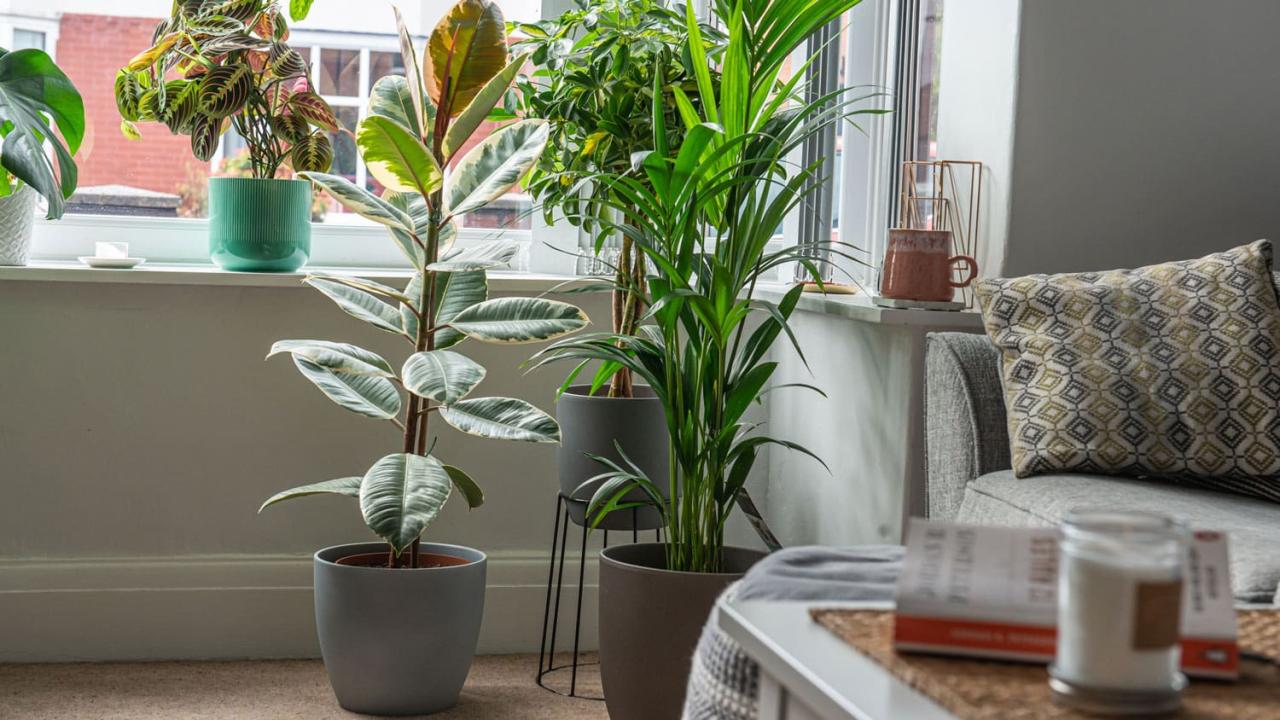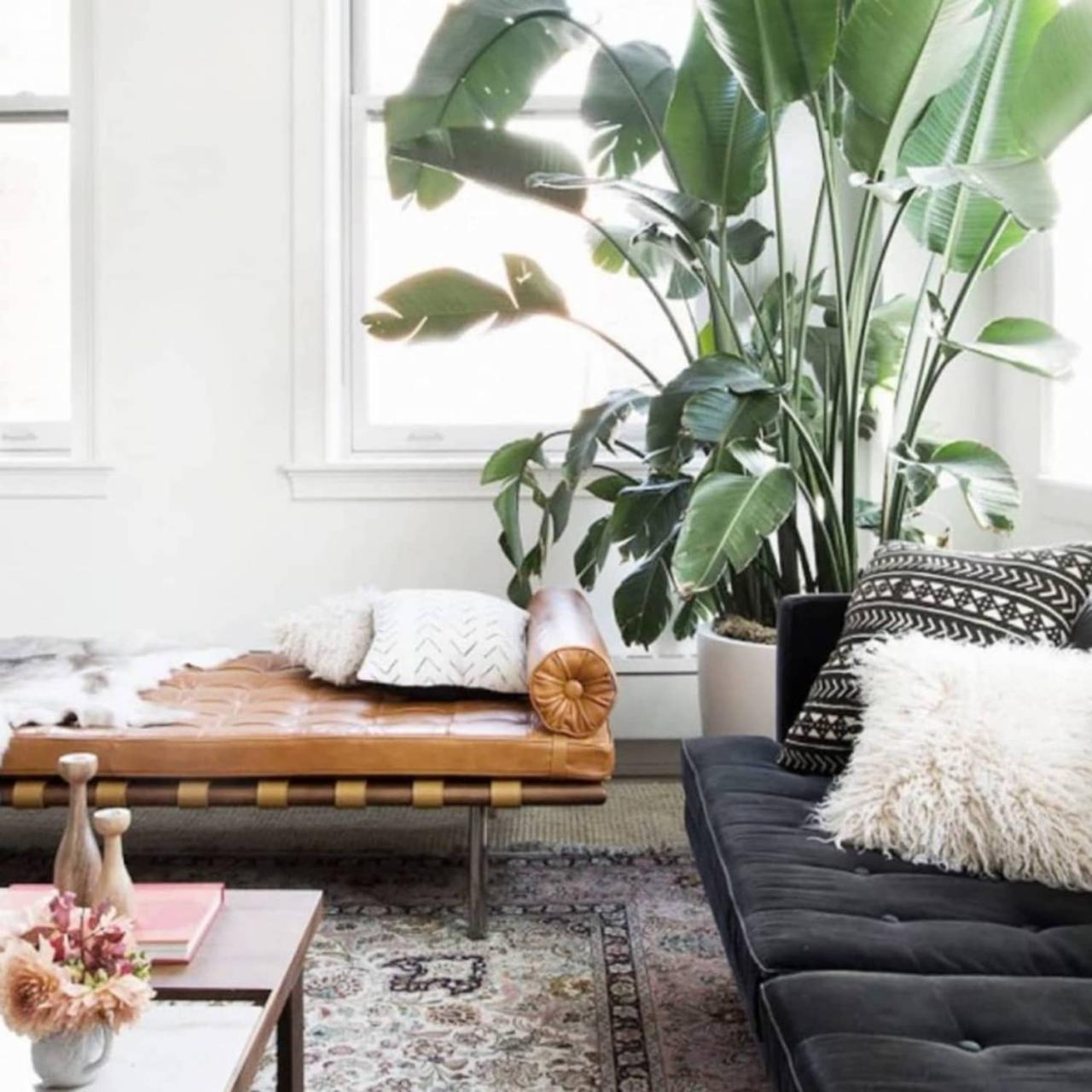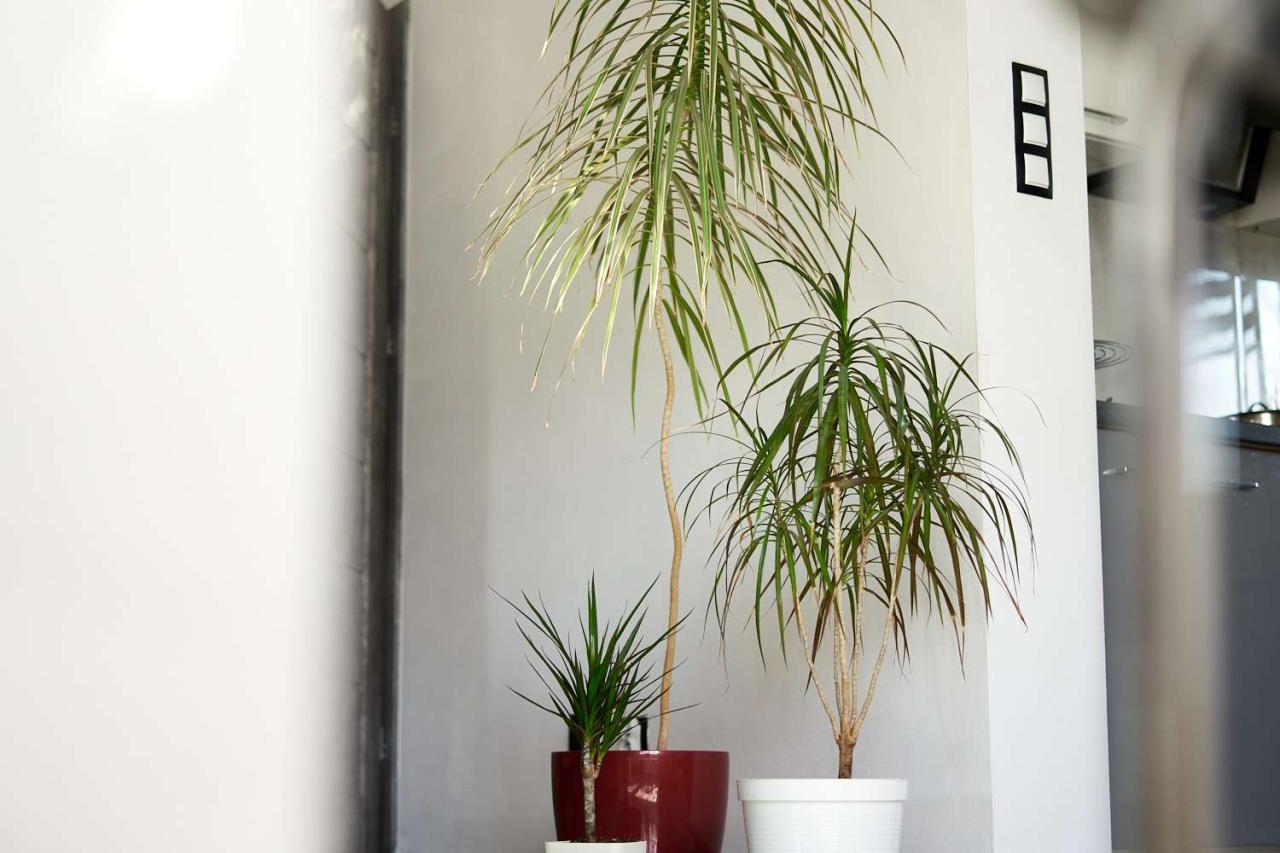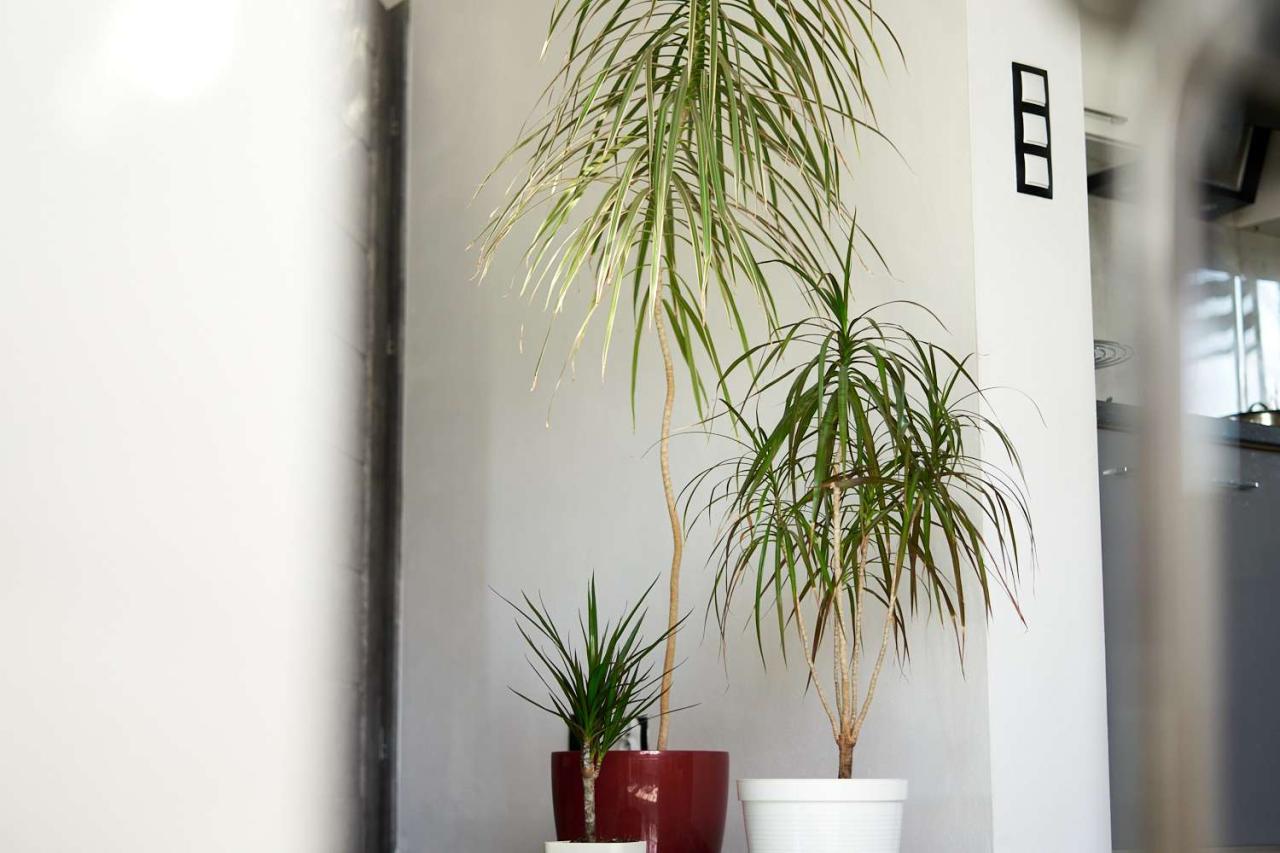8 Large Indoor Plants That Make a Statement sets the stage for this enthralling narrative, offering readers a glimpse into a story that is rich in detail with search engine journal author style and brimming with originality from the outset.
Transforming your home into a tranquil oasis is a dream shared by many, and adding large indoor plants is a fantastic way to achieve that. These leafy giants not only elevate your interior design but also bring a sense of serenity and life to your space.
But with so many options available, selecting the right plants for your home can feel overwhelming. This article will guide you through eight magnificent indoor plants that are sure to make a statement, each offering unique features and benefits.
From the striking foliage of the Fiddle Leaf Fig to the elegant white flowers of the Peace Lily, these plants bring a touch of nature indoors, enhancing both the aesthetics and the atmosphere of your home. Whether you’re seeking a dramatic centerpiece for your living room or a touch of greenery for your office, this list has something for every taste and style.
Let’s explore the world of large indoor plants and discover the perfect green companions for your home.
Large Indoor Plants That Make a Statement

Incorporating large indoor plants into your home decor can transform a space, infusing it with life, vibrancy, and a sense of tranquility. These verdant giants not only enhance the aesthetic appeal of your interiors but also contribute to a healthier and more serene environment.
Their presence creates a natural focal point, drawing the eye and adding a touch of the outdoors indoors. The choice of large indoor plants is vast, with each species offering unique characteristics and benefits. However, it’s crucial to select plants that thrive in indoor environments, considering factors like light requirements, humidity levels, and overall care needs.
Selecting Plants Suitable for Indoor Environments
Before bringing a large indoor plant home, it’s essential to consider its suitability for your indoor environment. Factors such as light availability, humidity levels, and your willingness to provide consistent care are crucial. Researching the specific needs of each plant is vital to ensure its long-term health and vitality.
8 Large Indoor Plants That Make a Statement
Large indoor plants can add a touch of nature and sophistication to any space. They can also help improve air quality and create a more relaxing atmosphere. If you’re looking to make a statement with your indoor greenery, here are eight large indoor plants that are sure to impress.
From the towering majesty of a fiddle leaf fig to the cascading elegance of a monstera deliciosa, large indoor plants can transform a space into a verdant oasis. While these statement plants are often admired for their size, smaller varieties like the money plant can offer a unique charm.
If you’re looking to create a miniature jungle, consider growing a money plant in a terrarium, following the detailed instructions found in How To Care For A Money Plant In A Terrarium. This low-maintenance plant thrives in enclosed environments and adds a touch of greenery to any corner, seamlessly blending into your collection of statement plants.
Large Indoor Plants, 8 Large Indoor Plants That Make a Statement
Plant Name |
Description |
Image |
Link |
|---|---|---|---|
Fiddle Leaf Fig (Ficus lyrata) |
Known for its large, fiddle-shaped leaves, the Fiddle Leaf Fig is a popular choice for its striking appearance. It can grow quite tall, making it a great statement piece in any room. |
[Image of a Fiddle Leaf Fig with its large, fiddle-shaped leaves and a tall, slender trunk.] |
[Link to a website with more information about Fiddle Leaf Figs] |
Bird’s Nest Fern (Asplenium nidus) |
The Bird’s Nest Fern features unique, wavy, and strap-like fronds that grow in a rosette pattern, resembling a bird’s nest. Its lush foliage adds a touch of tropical elegance to any space. |
[Image of a Bird’s Nest Fern with its wavy, strap-like fronds growing in a rosette pattern.] |
[Link to a website with more information about Bird’s Nest Ferns] |
Monstera Deliciosa |
The Monstera Deliciosa is known for its large, glossy leaves with distinctive holes and splits, adding a touch of drama and intrigue. It can grow quite large, making it an impressive focal point. |
[Image of a Monstera Deliciosa with its large, glossy leaves featuring holes and splits.] |
[Link to a website with more information about Monstera Deliciosa] |
Rubber Tree (Ficus elastica) |
The Rubber Tree is known for its large, glossy leaves and its ability to grow quite tall. It’s a popular choice for its air-purifying qualities and its ability to tolerate low light conditions. |
[Image of a Rubber Tree with its large, glossy leaves and a thick, sturdy trunk.] |
[Link to a website with more information about Rubber Trees] |
Snake Plant (Sansevieria trifasciata) |
The Snake Plant is known for its stiff, upright leaves with distinctive patterns. It’s a low-maintenance plant that can tolerate a wide range of conditions, making it a great choice for beginners. |
[Image of a Snake Plant with its stiff, upright leaves featuring distinctive patterns.] |
[Link to a website with more information about Snake Plants] |
Peace Lily (Spathiphyllum) |
The Peace Lily features elegant, white, and heart-shaped flowers that add a touch of elegance to any space. It’s known for its air-purifying qualities and its ability to thrive in low light conditions. |
[Image of a Peace Lily with its elegant, white, heart-shaped flowers and its lush, green foliage.] |
[Link to a website with more information about Peace Lilies] |
ZZ Plant (Zamioculcas zamiifolia) |
The ZZ Plant is known for its glossy, dark green leaves and its ability to tolerate low light and infrequent watering. It’s a very low-maintenance plant that can thrive in a variety of conditions. |
[Image of a ZZ Plant with its glossy, dark green leaves and its unique, clumping growth habit.] |
[Link to a website with more information about ZZ Plants] |
Elephant Ear (Alocasia) |
The Elephant Ear is known for its large, dramatic leaves that resemble elephant ears. It’s a striking plant that can add a tropical touch to any space. |
[Image of an Elephant Ear with its large, dramatic leaves that resemble elephant ears.] |
[Link to a website with more information about Elephant Ears] |
Fiddle Leaf Fig (Ficus lyrata)
The Fiddle Leaf Fig, with its large, violin-shaped leaves, has become a beloved choice for indoor plant enthusiasts. This tropical beauty adds a touch of elegance and sophistication to any space. Its striking foliage, characterized by its deep green color and prominent veins, can transform a room into a lush oasis.
Growing Conditions for Fiddle Leaf Figs
Fiddle Leaf Figs thrive in bright, indirect light, making them ideal for rooms with large windows. They prefer a consistently moist soil but should not be overwatered. Allowing the top inch of soil to dry out between waterings is essential.
Humidity is also crucial for their well-being. Regular misting or placing a humidifier nearby can help maintain the desired humidity levels.
Potential Challenges and Troubleshooting Tips
While Fiddle Leaf Figs are beautiful, they can be somewhat finicky. One common challenge is leaf drop. This can occur due to various factors, including underwatering, overwatering, changes in temperature, or low humidity. To address this, ensure the plant is receiving adequate water and humidity.Another common issue is brown leaf tips, which can be a sign of dry air or low humidity.
Increasing humidity levels can help prevent this problem. Finally, pests such as spider mites or mealybugs can sometimes infest Fiddle Leaf Figs. Regularly inspecting the plant for signs of pests and using appropriate treatment methods can help control infestations.
Monstera Deliciosa
The Monstera Deliciosa, also known as the Swiss Cheese Plant, is a popular choice for large indoor plants due to its striking foliage and relatively easy care requirements. This tropical plant is native to Central America and is known for its large, distinctive leaves that are deeply lobed, resembling a Swiss cheese.
Growth Habits
The Monstera Deliciosa is a vigorous climber in its natural habitat, and can grow to a considerable size indoors with proper care. Its aerial roots, which emerge from the stem, help the plant to climb and anchor itself. These roots can be encouraged to grow into the soil, further supporting the plant’s growth.
Light Requirements
Monstera Deliciosa plants thrive in bright, indirect light. They can tolerate some direct sunlight, but it’s best to avoid exposing them to harsh, midday sun, which can scorch the leaves. If you are growing your Monstera Deliciosa in a location that receives limited light, you can supplement with artificial light.
Watering Requirements
Monstera Deliciosa plants prefer their soil to be slightly moist but not soggy. Allow the top inch or two of soil to dry out between waterings. Overwatering is a common problem that can lead to root rot, so it’s important to let the soil dry out adequately before watering again.
While large indoor plants can bring a touch of the outdoors in, they also require careful maintenance. Just like cultivating a beautiful chamomile lawn, as described in this helpful guide How To Grow A Chamomile Lawn Without Chemicals , you need to ensure the right conditions for your plants to thrive.
From proper watering to adequate light, understanding the needs of your large indoor plants will help them flourish and make a striking statement in your home.
Support for Climbing
As your Monstera Deliciosa grows, it’s important to provide support for its climbing stems. This can be done with a variety of methods, including:
- Moss poles:These are poles covered in moss, which provide a natural and attractive support system for the plant’s aerial roots to cling to.
- Trellises:Trellises come in a variety of shapes and sizes, and can be used to create a more structured and vertical growth pattern.
- Hanging baskets:Monstera Deliciosa can also be grown in hanging baskets, allowing their stems to cascade downwards.
ZZ Plant (Zamioculcas zamiifolia)
The ZZ plant is a popular choice for indoor gardeners due to its hardiness and low-maintenance nature. This plant thrives in low-light conditions and can tolerate infrequent watering, making it an ideal choice for busy individuals or those who may not have a green thumb.
The ZZ plant’s striking foliage adds a touch of elegance to any room, making it a beautiful addition to any home or office.
The ZZ Plant’s Low-Maintenance Nature
The ZZ plant is known for its ability to tolerate a wide range of conditions, making it an excellent choice for beginner gardeners or those who may not have the time to dedicate to frequent plant care. This plant is remarkably drought-tolerant and can survive for weeks without water.
It also thrives in low-light conditions, making it suitable for placement in areas of the home that receive minimal natural light.
The ZZ Plant’s Striking Foliage
The ZZ plant features glossy, dark green leaves that grow in clusters from a central stem. The leaves are typically oval-shaped and can grow up to 12 inches long. This plant’s unique foliage adds a touch of elegance to any room and can complement a variety of interior design styles.
The ZZ Plant’s Potential for Invasiveness
While the ZZ plant is generally considered a safe and non-invasive plant, it’s important to note that it can become invasive in certain environments. This is due to its ability to reproduce through underground rhizomes. In tropical climates, the ZZ plant can escape cultivation and spread rapidly, potentially displacing native plant species.
Therefore, it’s essential to exercise caution when planting ZZ plants outdoors in warm climates.
Chinese Evergreen (Aglaonema)
The Chinese Evergreen is a popular choice for indoor gardeners due to its low-maintenance nature and striking foliage. These plants are known for their wide variety of colors and patterns, making them a versatile addition to any home décor.
Variety of Colors and Patterns
The Chinese Evergreen is a diverse plant, offering a wide range of colors and patterns. The leaves come in shades of green, red, pink, silver, and white, often with intricate markings and veins. Some popular varieties include:
- Aglaonema ‘Silver Queen’:Features silvery-green leaves with dark green veins.
- Aglaonema ‘Red Siam’:Exhibits deep red leaves with green veins and a hint of pink.
- Aglaonema ‘Pink Blush’:Showcases pink and green leaves with a silvery sheen.
- Aglaonema ‘Emerald Bay’:Displays vibrant green leaves with silver markings.
Low Light Tolerance and Adaptability
Chinese Evergreens are renowned for their ability to thrive in low light conditions. They can tolerate dimly lit corners and even thrive under artificial lighting, making them ideal for rooms with limited natural light. This adaptability allows them to flourish in various indoor environments, including apartments, offices, and homes with minimal sunlight.
Ideal Growing Conditions
While Chinese Evergreens are adaptable, providing them with optimal growing conditions can enhance their growth and appearance.
Humidity
Chinese Evergreens prefer moderate to high humidity levels. To maintain humidity, consider placing the plant near a humidifier, grouping it with other plants, or using a pebble tray filled with water.
Watering
Water the Chinese Evergreen thoroughly when the top inch of soil is dry. Allow excess water to drain from the pot to prevent root rot. Avoid overwatering, as this can lead to root problems.
Rubber Tree (Ficus elastica)

The Rubber Tree is a popular choice for large indoor plants, known for its striking appearance and adaptability. Its large, glossy leaves, which can grow up to 12 inches long, provide a dramatic focal point in any room. With proper care, this plant can reach heights of up to 10 feet indoors, making it an impressive statement piece.
Light and Watering Requirements
Rubber Trees thrive in bright, indirect light, but can tolerate some shade. Avoid placing them in direct sunlight, as this can scorch their leaves. The ideal watering schedule for Rubber Trees is to allow the top inch of soil to dry out between waterings.
Overwatering can lead to root rot, so it’s important to let the soil dry out completely before watering again.
Pruning a Rubber Tree
Pruning is essential for maintaining the shape and size of a Rubber Tree. It’s best to prune during the spring or summer when the plant is actively growing. To prune, simply cut back any stems or branches that are too long or unruly.
Pruning can also help to encourage bushier growth.
Snake Plant (Sansevieria trifasciata): 8 Large Indoor Plants That Make A Statement

The Snake Plant, also known as Mother-in-Law’s Tongue, is a popular choice for indoor plant enthusiasts due to its striking appearance and resilience. Its unique, upright leaves, often resembling swords, add a dramatic touch to any room. These plants are renowned for their ability to tolerate neglect, making them ideal for busy individuals or those who may forget to water their plants regularly.
Low Light Tolerance and Air-Purifying Qualities
Snake Plants are remarkably adaptable to low light conditions, thriving in areas that receive indirect sunlight. This makes them suitable for offices, bedrooms, or any space that lacks ample natural light. Beyond their aesthetic appeal, Snake Plants are also known for their air-purifying properties.
Studies have shown that they effectively remove toxins like formaldehyde, benzene, and trichloroethylene from the air, contributing to a healthier indoor environment.
Well-Draining Soil
Providing well-draining soil is crucial for the health of a Snake Plant. These plants are susceptible to root rot if their soil remains overly wet. A well-draining potting mix, often consisting of a combination of peat moss, perlite, and vermiculite, allows for proper aeration and prevents waterlogging.
Conclusion
Adding large indoor plants to your home offers a multitude of benefits, from enhancing air quality and reducing stress to creating a more vibrant and welcoming atmosphere. By carefully selecting plants that suit your space and care preferences, you can create a stunning and thriving indoor jungle.
This article explored eight large indoor plants that make a statement, each with its unique characteristics and care requirements. From the majestic Fiddle Leaf Fig to the striking Monstera Deliciosa, these plants offer a wide range of options to transform your home into a verdant oasis.
Exploring the World of Large Indoor Plants
Beyond the plants discussed in this article, there is a vast world of large indoor plants waiting to be discovered. Researching different species, considering your space and light conditions, and seeking guidance from experienced plant enthusiasts can help you find the perfect plants to enhance your home.
Wrap-Up
As you’ve discovered, large indoor plants offer a wealth of benefits, from enhancing your home’s decor to improving air quality. With this guide, you’re equipped to choose the perfect plants to create a vibrant and inviting atmosphere. Remember, each plant has its unique needs, so understanding their light, watering, and humidity preferences is crucial for their healthy growth.
Whether you’re a seasoned plant parent or just starting your indoor gardening journey, these magnificent plants are sure to bring a touch of nature’s beauty and tranquility to your home. Embrace the joy of indoor gardening and let these leafy giants transform your space into a lush and inviting sanctuary.
Detailed FAQs
What are the best ways to care for large indoor plants?
Providing the right amount of light, water, and humidity is crucial for the health of your large indoor plants. Research each plant’s specific needs and adjust your care routine accordingly. Regular fertilization and repotting when necessary can also contribute to their overall well-being.
Are large indoor plants suitable for all homes?
While large indoor plants can add a touch of elegance to any home, it’s essential to consider the available space and light conditions. Some plants thrive in bright, indirect light, while others prefer low light conditions. Choose plants that will thrive in your home’s environment to ensure their long-term health and beauty.
Can I grow large indoor plants from seeds or cuttings?
Yes, you can propagate large indoor plants from seeds or cuttings. However, this can be a more challenging process than buying a mature plant. If you’re a beginner, it’s recommended to start with a mature plant to ensure success.
If you’re interested in propagation, there are many resources available online and at your local garden center.
